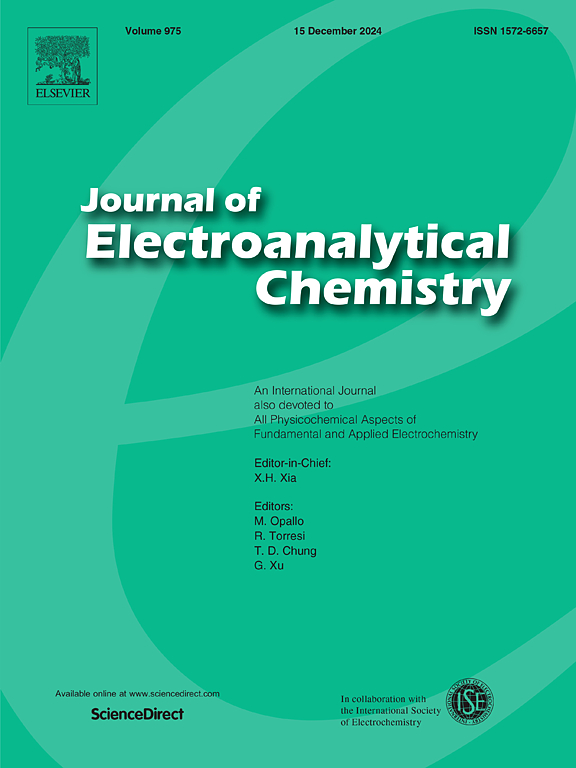用于锂离子电池负极材料的掺杂 Ce 的 Li4Ti5O12 的核壳结构和高倍率性能
IF 4.1
3区 化学
Q1 CHEMISTRY, ANALYTICAL
引用次数: 0
摘要
钛酸锂(LTO)具有抑制锂枝晶生长的固有能力和独特的 "零应变 "特性,因此是一种非常有前途的锂离子电池(LSB)负极材料。遗憾的是,LTO 的低电子传导性导致其在更高的电化学要求下存在严重缺陷。在这项工作中,以碳球为模板,通过水热法合成的掺杂 Ce3+ 的 C@Li4Ti5-xCexO12(x = 0、0.1、0.15 和 0.2)正极材料在结构和电化学性能方面都有了更显著的改善。结果表明,C@Li4Ti5-xCexO12(x = 0.1、0.15 和 0.2)电极的电子电导率、锂离子扩散率、放电比容量、放电速率能力和稳定性都有显著提高。其中,C@Li4Ti4.85Ce0.15O12 电极在 0.1C 时的初始放电比容量(250.86 mAh/g)最高,是 C@Li4Ti5O12 (195.94 mAh/g)的 1.28 倍,500 次循环后的初始放电容量从 205.96 mAh/g 降至 170.39 mAh/g,相当于初始稳定放电容量的 82.7%。C@Li4Ti4.85Ce0.15O12 的优异性能可归因于较低的界面阻抗、较高的电子电导率、较高的氧空位浓度以及适量的 Ce3+ 掺杂可增强电化学活性。此外,碳球表面缺陷也能有效改善锂离子存储。这项研究表明,掺杂 Ce3+ 是提高 LTO 电化学性能的有效方法,并为锂离子电池负极电极材料的设计和优化提供了更有效的指导。本文章由计算机程序翻译,如有差异,请以英文原文为准。
Core-shell structure and high rate performance of Ce-doped Li4Ti5O12 for lithium-ion battery anode materials
Lithium titanate (LTO) can be a very promising anode material for lithium-ion batteries (LSBs) due to its inherent ability to inhibit the growth of lithium dendrites as well as its unique “zero-strain” properties. Unfortunately, the low electronic conductivity of LTO leads to serious shortcomings in higher electrochemical demands. In this work, the Ce3+-doped C@Li4Ti5-xCexO12 (x = 0, 0.1, 0.15 and 0.2) anode materials synthesized by the hydrothermal method using carbon spheres as templates showed more significant improvement in both structural and electrochemical properties. The results demonstrate that electronic conductivity, lithium-ion diffusion rate, discharge specific capacity, discharge rate capability, and significant improvement stability of C@Li4Ti5-xCexO12 (x = 0.1, 0.15 and 0.2) electrodes. Among them, C@Li4Ti4.85Ce0.15O12 electrode exhibits the highest initial discharge specific capacity (250.86 mAh/g) at 0.1C, which is 1.28-fold that of C@ Li4Ti5O12 (195.94 mAh/g), and initial discharge capacity from 205.96 mAh/g to 170.39 mAh/g after 500 cycles, corresponding to 82.7 % of the initial stable discharge capacity. The outstanding performance of C@Li4Ti4.85Ce0.15O12 can be attributed to the lower interfacial impedance, higher electronic conductivity, high oxygen vacancy concentration, and moderate amount of Ce3+ doping can enhance the electrochemical activity. In addition, carbon sphere surface defects shown to be effective in improving lithium-ion storage. This work demonstrates that Ce3+ doping is an effective method to improve the electrochemical performance of LTOs and provides a more effective guide for designing and optimizing anode electrode materials for lithium-ion batteries.
求助全文
通过发布文献求助,成功后即可免费获取论文全文。
去求助
来源期刊
CiteScore
7.80
自引率
6.70%
发文量
912
审稿时长
2.4 months
期刊介绍:
The Journal of Electroanalytical Chemistry is the foremost international journal devoted to the interdisciplinary subject of electrochemistry in all its aspects, theoretical as well as applied.
Electrochemistry is a wide ranging area that is in a state of continuous evolution. Rather than compiling a long list of topics covered by the Journal, the editors would like to draw particular attention to the key issues of novelty, topicality and quality. Papers should present new and interesting electrochemical science in a way that is accessible to the reader. The presentation and discussion should be at a level that is consistent with the international status of the Journal. Reports describing the application of well-established techniques to problems that are essentially technical will not be accepted. Similarly, papers that report observations but fail to provide adequate interpretation will be rejected by the Editors. Papers dealing with technical electrochemistry should be submitted to other specialist journals unless the authors can show that their work provides substantially new insights into electrochemical processes.

 求助内容:
求助内容: 应助结果提醒方式:
应助结果提醒方式:


